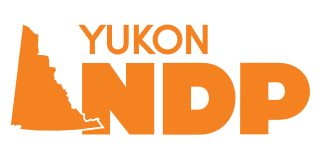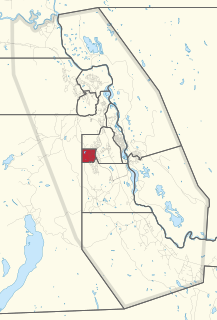
Whitehorse is the capital and only city of Yukon, and the largest city in northern Canada. It was incorporated in 1950 and is located at kilometre 1426 on the Alaska Highway in southern Yukon. Whitehorse's downtown and Riverdale areas occupy both shores of the Yukon River, which rises in British Columbia and meets the Bering Sea in Alaska. The city was named after the White Horse Rapids for their resemblance to the mane of a white horse, near Miles Canyon, before the river was dammed.

Yukon is the smallest and westernmost of Canada's three territories. It also is the least populated province or territory in Canada, with a population of 35,874 people as of the 2016 Census. Whitehorse, the territorial capital, is the largest settlement in any of the three territories.

The provinces and territories of Canada are sub-national divisions within the geographical areas of Canada under the jurisdiction of the Canadian Constitution. In the 1867 Canadian Confederation, three provinces of British North America—New Brunswick, Nova Scotia, and the Province of Canada —united to form a federation, becoming a fully independent country over the next century. Over its history, Canada's international borders have changed several times, and the country has grown from the original four provinces to the current ten provinces and three territories. Together, the provinces and territories make up the world's second-largest country by total area.

The Yukon New Democratic Party is a social-democratic political party in the Yukon territory of Canada.

The Legislative Assembly of the Northwest Territories, or Legislative Council of the Northwest Territories, is the legislature and the seat of government of Northwest Territories in Canada. It is a unicameral elected body that creates and amends law in the Northwest Territories. Permanently located in Yellowknife since 1993, the assembly was founded in 1870 and became active in 1872 with the first appointments from the Government of Canada.

Yukon University is a public university in the Canadian territory of Yukon. The university main campus is based in Whitehorse, although the institution also operates several off-campus campuses and facilities throughout the territory. The university confers bachelor's degrees, diplomas, as well as offer vocational training. The institution is the only university based in northern Canada.
Peter William Jenkins is a Canadian politician, who has served as deputy premier and health minister in the territorial government of the Yukon, and as mayor of Dawson City.

Whitehorse West is an electoral district which returns a member to the Legislative Assembly of the Yukon Territory in Canada.
Riverdale is a neighbourhood within the city of Whitehorse, Yukon, Canada. The community is separated from Whitehorse City Centre by the Yukon River, and is linked to Whitehorse via Lewes Boulevard, a major thoroughfare in the community.
Ted Staffen is a Canadian politician, who represented the electoral district of Riverdale North in the Yukon Legislative Assembly as a member of the Yukon Party from 2002 to 2011. He served as the 9th Speaker of the Legislative Assembly from 2003 to 2011.
The Yukon Territorial Council was a political body in the Canadian territory of Yukon, prior to the creation of the Yukon Legislative Assembly. Although not a full legislature, the council acted as an advisory body to the Commissioner of Yukon, and had the power to pass non-binding motions of legislation which would be forwarded to the commissioner for consideration.
The Yukon order of precedence is a nominal and symbolic hierarchy of important positions within the territory of Yukon. It has no legal standing but is used to dictate ceremonial protocol at events of a territorial nature.
- The Queen of Canada
- The Governor General of Canada (Vacant)
- The Commissioner of Yukon
- Members of the Canadian Royal Family
- The Premier of Yukon
- The Speaker of the Yukon Legislative Assembly
- The Justices of the Supreme Court of Yukon
- Members of the Executive Council of Yukon
- The Leader of the Official Opposition
- Members of the Yukon Legislative Assembly with precedence governed by the date of their first election to the Legislature
- Member of the Senate for the Yukon
- Member of Parliament for the Yukon
- Yukon First Nation Chiefs and Council of Yukon First Nations
- Bishops of Roman Catholic and Anglican faiths with precedence determined by order of appointment
- R.C.M.P. Divisional Commanding Officer
- Armed Forces Commander
- Judges of the Territorial Court of Yukon
- The Mayor of Whitehorse
- Yukon Government Deputy Ministers and senior Yukon Government officials with the status of Deputy Ministers, with precedence according to the respective dates of their appointments to the position
Haakon Arntzen is a Canadian politician. He represented the Whitehorse, Yukon electoral district of Copperbelt in the Yukon Legislative Assembly as a member of the Yukon Party from 2002 to 2005.

The Whitehorse Waterfront Trolley was a heritage streetcar service in Whitehorse, Yukon, Canada.

Downtown Whitehorse is a neighbourhood in Whitehorse, Yukon. The downtown area serves as Whitehorse's city centre and central business district.
Kate White is a Canadian politician, who was elected to in the Yukon Legislative Assembly in the 2011 election. She represents the Whitehorse electoral district of Takhini-Kopper King as a member of the Yukon New Democratic Party caucus.
The following outline is provided as an overview of and topical guide to Yukon.
John (Jack) Hibberd was a Canadian politician and medical doctor, who represented the electoral district of Whitehorse South Centre in the Yukon Territorial Council and the Legislative Assembly of Yukon from 1974 to 1981.
Pelly River was a territorial electoral district in the Canadian territory of Yukon, which was represented on the Yukon Territorial Council from 1974 to 1978. The district consisted primarily of town of Faro, as well as much of the rural northeast quadrant of Yukon.











